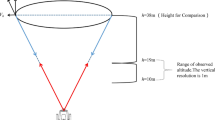Abstract
The purpose of the study was to evaluate potential locations for the installation of small wind turbines in urban areas. Four study sites in An-Ping, Tainan were chosen for measurement in this empirical study. The measurement data were used to verify the computational fluid dynamics (CFD) model. The weather information was gathered in order to understand the overall wind environment in the studied area. CFD software was used to simulate the wind environment in the study area from 16 directions. The distribution of wind environment was first presented, and then the distribution of exceedance probability in each grid, which was based on an exceedance probability assessment, was obtained. In addition to the installation heights of the turbines, the influence of surrounding buildings was taken into consideration. Finally, a wind energy potential map indicating the potential regions and non-potential regions for installing small wind turbines was illustrated by the ArcGIS system. A wind energy potential map, superimposed with locations of buildings of different floor heights, was used to evaluate the possible sites for the installment of small wind turbines at heights of 10, 20, and 30 m. The results proved that installing micro wind turbines in open spaces and on the roofs of three-, four-, and five-story buildings at a height of 20 m is relatively beneficial for coastal urban areas.










Similar content being viewed by others
References
Steffen, W. (2008). Working Group 1 report of the IPCC Fourth Assessment—an editorial, Global Environment Change. The Fenner School of Environment and Society, 18(1), 1–3.
Zervos, A., & Teske, S. (2009). Energy revolution. Belgium: European Renewable Energy Council.
Mostafaeipour, A. (2010). Feasibility study of harnessing wind energy for turbine installation in province of Yazd in Iran. Renewable and Sustainable Energy Reviews, 14(1), 93–111.
Justin, W. (2010). Wind in power 2009 European statistics. Belgium: European Wind Energy Association.
Bahaj, A. S., Myers, L., & James, P. A. B. (2007). Urban energy generation: influence of micro-wind turbine output on electricity consumption in buildings. Energy and Buildings, 39(2), 154–165.
Chuang, C.-H. (2009). Analysis and estimation of wind power for the small wind turbine installed in urban tall buildings—the new building of the Institute of Physics, Academia Sinica in Taipei city as an example. Master, National Taiwan Ocean University.
Ettoumi, F. Y., Adane, A. E. H., Benzaoui, M. L., & Bouzergui, N. (2008). Comparative simulation of wind park design and siting in Algeria. Renewable Energy, 33(10), 2333–2338.
Adaramola, M. S., & Oyewola, O. M. (2011). Evaluating the performance of wind turbines in selected locations in Oyo state, Nigeria. Renewable Energy, 36(12), 3297–3304.
Himri, Y., Rehman, S., Draoui, B., & Himri, S. (2007). Wind power potential assessment for three locations in Algeria. Renewable and Sustainable Energy Reviews, 12(9), 2495–2504.
Persaud, S., Flynn, D., & Fox, B. (1999). Potential for wind generation on the Guyana coastlands. Renewable Energy, 18(2), 175–189.
Khan, M. J., Iqbal, M. T., & Mahboob, S. (2004). A wind map of Bangladesh. Renewable Energy, 29(5), 643–660.
Brunskill, A. W., & Lubitz, W. D. (2012). A neural network shelter model for small wind turbine siting near single obstacles. Wind and Structures, 15(1), 43–64.
Rodman, L. C., & Meentemeyer, R. K. (2006). A geographic analysis of wind turbine placement in Northern California. Energy Policy, 34(15), 2137–2149.
Yeh, K. P. (2007). A study of Taiwan’s energy market problems. Master Thesis: National Sun Yat-Sen University.
Bureau of Energy, Taiwan (ROC), Ministry of Economic Affairs, Taiwan (ROC) (2003). Distribution of basic wind power in Taiwan.
Chang, X. L., Kuo, H. C., Chang, S. H., & Lin, J. M. (2007). Wind energy generation technology. Taiwan: Wun-Ching Publishing Group.
Chang, T. J., Wu, Y. T., Hsu, H. Y., Chu, C. R., & Liao, C. M. (2003). Assessment of wind characteristics and wind turbine characteristics in Taiwan. Renewable Energy, 28(6), 851–871.
Oke, T. (1988). Boundary layer climates (2 Sub edition ed). London: Methuen.
Grimmond, C. S. B., & Oke, T. R. (2002). Turbulent heat fluxes in urban areas: observations and a local-scale urban meteorological parameterization scheme (LUMPS). Journal of Applied Meteorology, 41(7), 792–810.
Franke, J. (2006). Introduction to the prediction of wind loads on buildings by computational wind engineering (CWE). In S. Ted & C. B. Charalambos (Eds.), Wind effects on buildings and design of wind-sensitive structures (pp. 66–86). NewYork: Springer
Hu, C. H., & Wang, F. (2005). Using a CFD approach for the study of street-level winds in a built-up area. Building and Environment, 40(5), 617–631.
Ono, T., Murakami, S., Ooka, R., & Omori, T. (2008). Numerical and experimental study on convective heat transfer of the human body in the outdoor environment. Journal of Wind Engineering and Industrial Aerodynamics, 96(10–11), 1719–1732.
Mochida, A., & Lun, I. Y. F. (2008). Prediction of wind environment and thermal comfort at pedestrian level in urban area. Journal of Wind Engineering and Industrial Aerodynamics, 96(10–11), 1498–1527.
Tominaga, Y., Mochida, A., Yoshie, R., Kataoka, H., Nozu, T., Yoshikawa, M., & Shirasawa, T. (2008). AIJ guidelines for practical applications of CFD to pedestrian wind environmentaround buildings. Journal of Wind Engineeringand Industrial Aerodynamics, 96(10–11), 1749–1761.
Stavrakakis, G. M., Koukou, M. K., Vrachopoulos, M. G., & Markatos, N. C. (2008). Natural cross-ventilation in buildings: building-scale experiments, numerical simulation and thermal comfort evaluation. Energy and Buildings, 40, 1666–1681.
The Ministry of Interior (2006). The regulation and explanation of wind-resistant design of buildings. Taipei: Construction Magazine Publisher.
Acknowledgments
This work was financially supported by a grant-in-aid for scientific research by the National Science Council of Taiwan under grant NSC 100-26231-E-006-002-ET.
Author information
Authors and Affiliations
Corresponding author
Rights and permissions
About this article
Cite this article
Hsieh, CM., Fu, CK. Evaluation of Locations for Small Wind Turbines in Costal Urban Areas Based on a Wind Energy Potential Map. Environ Model Assess 18, 593–604 (2013). https://doi.org/10.1007/s10666-013-9365-3
Received:
Accepted:
Published:
Issue Date:
DOI: https://doi.org/10.1007/s10666-013-9365-3




